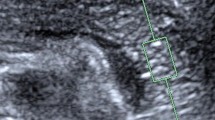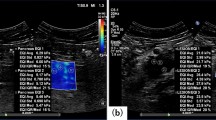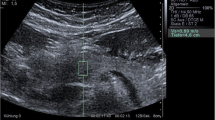Abstract
Purpose
We aimed to evaluate the success rate, repeatability, and factors affecting the measurement values of two-dimensional ultrasonic shear wave elastography (2D-SWE) for measuring pancreatic stiffness.
Methods
This prospective study recruited 100 healthy participants. 2D-SWE was performed on the pancreatic head, body, and tail. We compared the success rates of pancreatic stiffness measurements of different body positions and ultrasonic scans, with and without probe pressurization, as well as the effects of sex, age, body mass index (BMI), and region of interest (ROI) depth on measurement values. Intra- and inter-operator repeatabilities were assessed in 20 participants. The influence of ROI depth was verified using a tissue-like phantom.
Results
The median 2D-SWE measurements of the pancreatic head, body, and tail were 1.44, 1.45, and 1.56 m/s, respectively. The success rates for the pancreatic head and body were significantly higher than that of the tail. The success rate for the semi-recumbent position was higher than that of the supine position (P < 0.001). The intra-operator values for same-day and inter-operator reliability were excellent. Univariate analyses showed that probe pressurization, age, BMI, and ROI depth were correlated with pancreatic shear wave velocity (SWV) (P < 0.05); only ROI depth had a significant effect on SWV values. The inclusion phantom showed that the SWV value increased as the ROI depth increased.
Conclusions
2D-SWE had a high success rate and good repeatability for measuring pancreatic head and body stiffness. The ROI depth was the main factor affecting pancreatic SWV, which increased with ROI depth.



Similar content being viewed by others
References
Bamber J, Cosgrove D, Dietrich CF, et al. EFSUMB guidelines and recommendations on the clinical use of ultrasound elastography. Part 1: basic principles and technology. Ultraschall Med. 2013;34:169–84.
Hirooka Y, Kuwahara T, Irisawa A, et al. JSUM ultrasound elastography practice guidelines: pancreas. J Med Ultrason. 2015;42:151–74.
Bercoff J, Tanter M, Fink M. Supersonic shear imaging: a new technique for soft tissue elasticity mapping. IEEE Trans Ultrason Ferroelectr Freq Control. 2004;51:396–409.
Bavu E, Gennisson JL, Couade M, et al. Noninvasive in vivo liver fibrosis evaluation using supersonic shear imaging: a clinical study on 113 hepatitis C virus patients. Ultrasound Med Biol. 2011;37:1361–73.
Arda K, Ciledag N, Aktas E, Aribas BK, Köse K. Quantitative assessment of normal soft-tissue elasticity using shear-wave ultrasound elastography. AJR Am J Roentgenol. 2011;197:532–6.
Zaro R, Dina L, Pojoga C, Vesa S, Badea R. Evaluation of the pancreatic tumors by transabdominal shear wave elastography: preliminary results of a pilot study. Med Ultrason. 2018;20:285–91.
Dietrich CF, Hocke M. Elastography of the pancreas, current view. Clin Endosc. 2019;52:533–40.
Nguyen MM, Zhou S, Robert JL, Shamdasani V, Xie H. Development of oil-in-gelatin phantoms for viscoelasticity measurement in ultrasound shear wave elastography. Ultrasound Med Biol. 2014;40:168–76.
Hazra A, Gogtay N. Biostatistics series module 6: correlation and linear regression. Indian J Dermatol. 2016;61:593–601.
Boursier J, Konaté A, Gorea G, et al. Reproducibility of liver stiffness measurement by ultrasonographic elastometry. Clin Gastroenterol Hepatol. 2008;6:1263–9.
Hudson JM, Milot L, Parry C, Williams R, Burns PN. Inter- and intra-operator reliability and repeatability of shear wave elastography in the liver: a study in healthy volunteers. Ultrasound Med Biol. 2013;39:950–5.
Ohno E, Hirooka Y, Kawashima H, et al. Feasibility and usefulness of endoscopic ultrasonography-guided shear-wave measurement for assessment of autoimmune pancreatitis activity: a prospective exploratory study. J Med Ultrason. 2019;46:425–33.
Wang CZ, Zheng J, Huang ZP, et al. Influence of measurement depth on the stiffness assessment of healthy liver with real-time shear wave elastography. Ultrasound Med Biol. 2014;40:461–9.
Ferraioli G, Filice C, Castera L, et al. WFUMB guidelines and recommendations for clinical use of ultrasound elastography: part 3: liver. Ultrasound Med Biol. 2015;41:1161–79.
Sporea I, Bota S, Peck-Radosavljevic M, et al. Acoustic radiation force impulse elastography for fibrosis evaluation in patients with chronic hepatitis C:an international multicenter study. Eur J Radiol. 2012;81:4112–8.
Cassinotto C, Lapuyade B, Aït-Ali A, et al. Liver fibrosis: noninvasive assessment with acoustic radiation force impulse elastography–comparison with FibroScan M and XL probes and FibroTest in patients with chronic liver disease. Radiology. 2013;269:283–92.
Yashima Y, Sasahira N, Isayama H, et al. Acoustic radiation force impulse elastography for noninvasive assessment of chronic pancreatitis. J Gastroenterol. 2012;47:427–32.
Kuwahara T, Hirooka Y, Kawashima H, et al. Quantitative evaluation of pancreatic tumor fibrosis using shear wave elastography. Pancreatology. 2016;16:1063–8.
Kawada N, Tanaka S, Uehara H, et al. Potential use of point shear wave elastography for the pancreas: a single center prospective study. Eur J Radiol. 2014;83:620–4.
Zaro R, Lupsor-Platon M, Cheviet A, Badea R. The pursuit of normal reference values of pancreas stiffness by using acoustic radiation force impulse (ARFI) elastography. Med Ultrason. 2016;18:425–30.
Lam AC, Pang SW, Ahuja AT, Bhatia KS. The influence of precompression on elasticity of thyroid nodules estimated by ultrasound shear wave elastography. Eur Radiol. 2016;26:2845–52.
Stumpf S, Jaeger H, Graeter T, et al. Elasto-study group ulm. Influence of age, sex, body mass index, alcohol, and smoking on shear wave velocity (p-SWE) of the pancreas. Abdom Radiol (NY). 2016;41:1310–6.
Goertz RS, Schuderer J, Strobel D, Pfeifer L, Neurath MF, Wildner D. Acoustic radiation force impulse shear wave elastography (ARFI) of acute and chronic pancreatitis and pancreatic tumor. Eur J Radiol. 2016;85:2211–6.
Püttmann S, Koch J, Steinacker JP, et al. Ultrasound point shear wave elastography of the pancreas: comparison of patients with type 1 diabetes and healthy volunteers—results from a pilot study. BMC Med Imaging. 2018;18:52.
He Y, Jin Y, Li X, Wu L, Jin C. Quantification of pancreatic elasticity in type 2 diabetes: a new potential imaging marker for evaluation of microangiopathy. Eur J Radiol. 2020;124:108827.
Ozturk M, Çalışkan E, Bayramoglu Z, Adaletli I. Normative values of pancreas stiffness by shear wave elastography in healthy children and adolescents. J Med Ultrason. 2020;47:583–9.
Potthoff A, Attia D, Pischke S, et al. Influence of different frequencies and insertion depths on the diagnostic accuracy of liver elastography by acoustic radiation force impulse imaging (ARFI). Eur J Radiol. 2013;82:1207–12.
Zhao H, Song P, Urban MW, et al. Bias observed in time-of-flight shear wave speed measurements using radiation force of a focused ultrasound beam. Ultrasound Med Biol. 2011;37:1884–92.
Acknowledgements
This work was supported by the Joint Funds for the Innovation of Science and Technology of Fujian Province (2019Y9066).
Author information
Authors and Affiliations
Corresponding author
Ethics declarations
Conflict of interest
None.
Additional information
Publisher's Note
Springer Nature remains neutral with regard to jurisdictional claims in published maps and institutional affiliations.
Supplementary Information
Below is the link to the electronic supplementary material.
About this article
Cite this article
Zhuo, M., Zhang, X., Tang, Y. et al. Two-dimensional shear wave elastography of the pancreas: measurement success rate, repeatability, and factors affecting measurement values. J Med Ultrasonics 49, 261–268 (2022). https://doi.org/10.1007/s10396-022-01198-3
Received:
Accepted:
Published:
Issue Date:
DOI: https://doi.org/10.1007/s10396-022-01198-3




